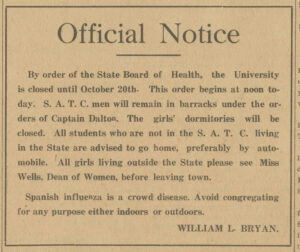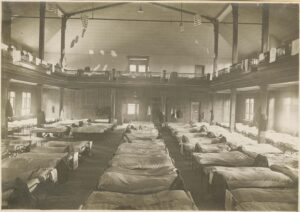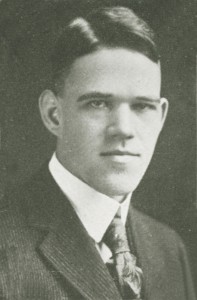The fourth in a five-part series highlighting Indiana University’s role in the first World War.

In the fall of 1918 Indiana University had 1,935 students, which was the largest enrollment to date. This record number, however, corresponded with the outbreak of the Spanish Flu epidemic, and, that fall, numerous students fell ill. President Bryan and the administration were forced to make the decision on October 10, 1918, to close the University for ten days — until October 20th. All students not in the Student Army Training Corps were asked to go home until the university reopened.

Sixty percent of the school’s population however were members of the S.A.T.C. and were required by army regulations to remain on campus. Thus, to fight the outbreak effectively, hospital beds were set up in Assembly Hall (the old Assembly Hall) and the auditorium of the Student Building. The peak of the epidemic at IU hit on October 16th, with 174 cases of influenza. In light of the continued prevalence of influenza on campus, the administration extended the closure of the university until November 4th.
S.A.T.C. member and IU student, William Ringer, contracted the flu and wrote about his experience illness in his diary on October 18, 1918:

I felt rotten, and could scarcely hold up my head while Rawles rambled away. . . . I felt worse all day, ate only a little dinner. The next morning I felt rotten, and did not get up until 7:30. There were four of us stumbled down to the infirmary where there was the sickest looking bunch of fellows I ever saw. He ordered us to the hospital, so we walked back to the barracks and lay there all day until a taxi came for us. I was put on a cot on the lower floor after some delay, and there I settled down for 6 days’ sickness. And I was pretty sick for three or four days. My temperature got only as high as 102.6 but it stayed up north stubbornly. They took good care of us, gave us plenty of very good food. . . . Horace [his brother] was brought in Saturday, and put on the stage. He was more sick than I, had a slight congestion in one lung, and had to wear a pneumonia jacket.
[You can read the original diary at the University Archives.]
Even after classes resumed, people were still being cared for at the University Hospital. In total, 350 people were hospitalized at IU during the fall influenza outbreak. Thanks to the nursing staff and warm hospital quarters only three people died, a mortality rate of less than one percent. That is much less than the estimated global mortality rate of 10%.
Flu cases continued to crop up into the spring 1919 semester. As a result, a late winter basketball game against the University of Iowa was supposed to be closed to the public to prevent the flu’s spread. Despite the risk, five hundred students made it past security in order to watch the game. According to IU basketball player Ardith Phillips, they were “500 of the most enthusiastic spectators you ever saw.”
Leave a Reply